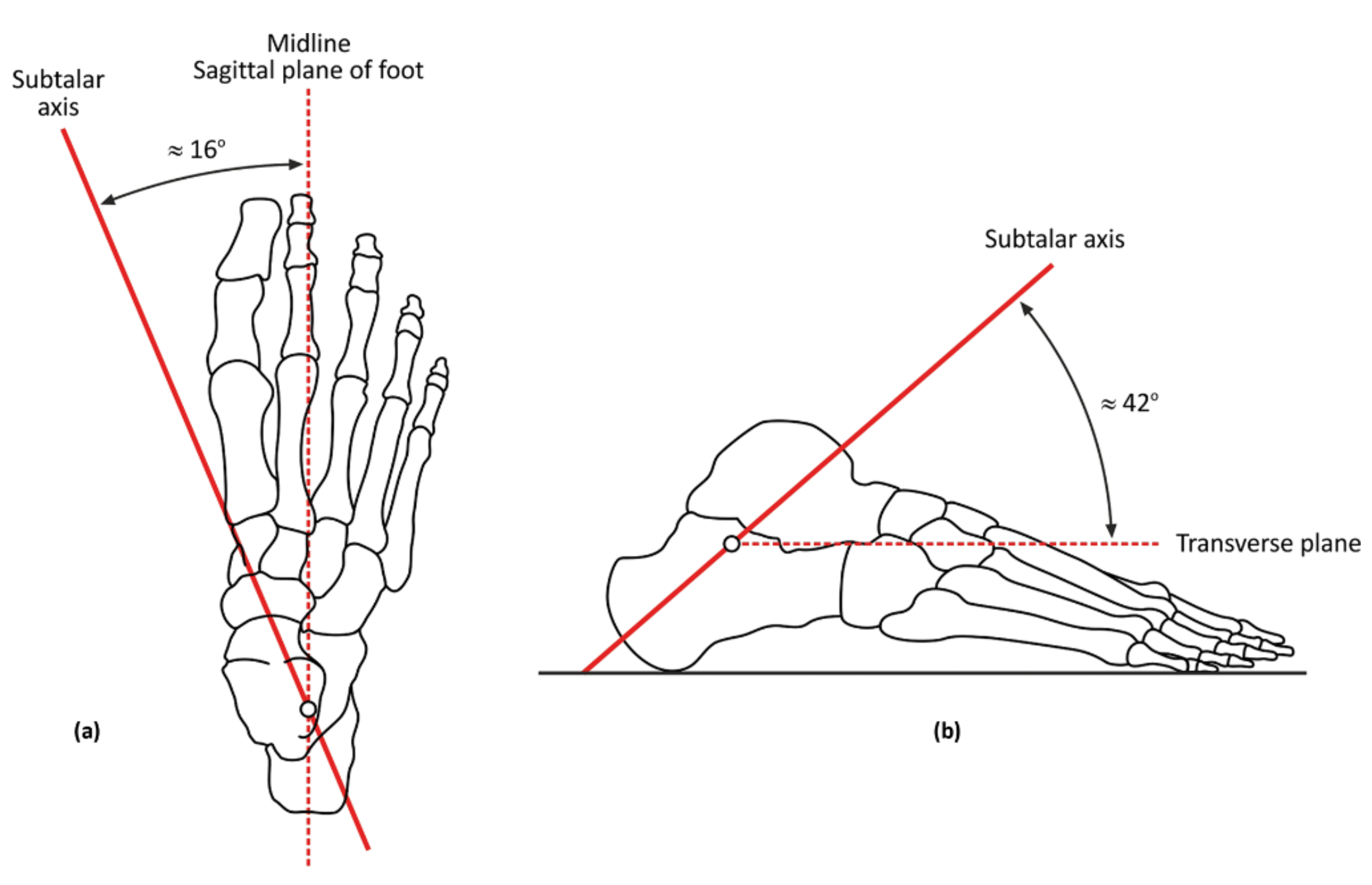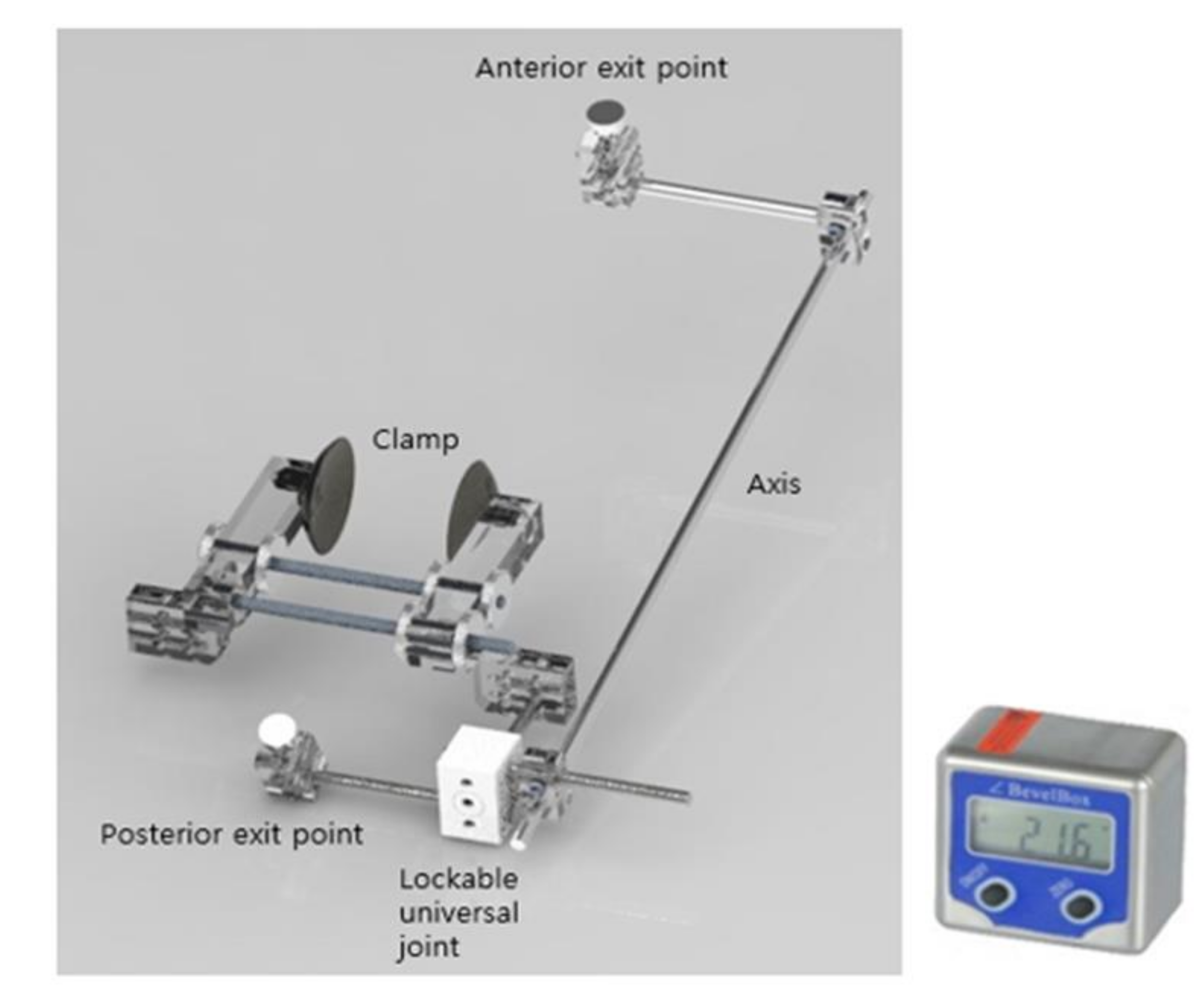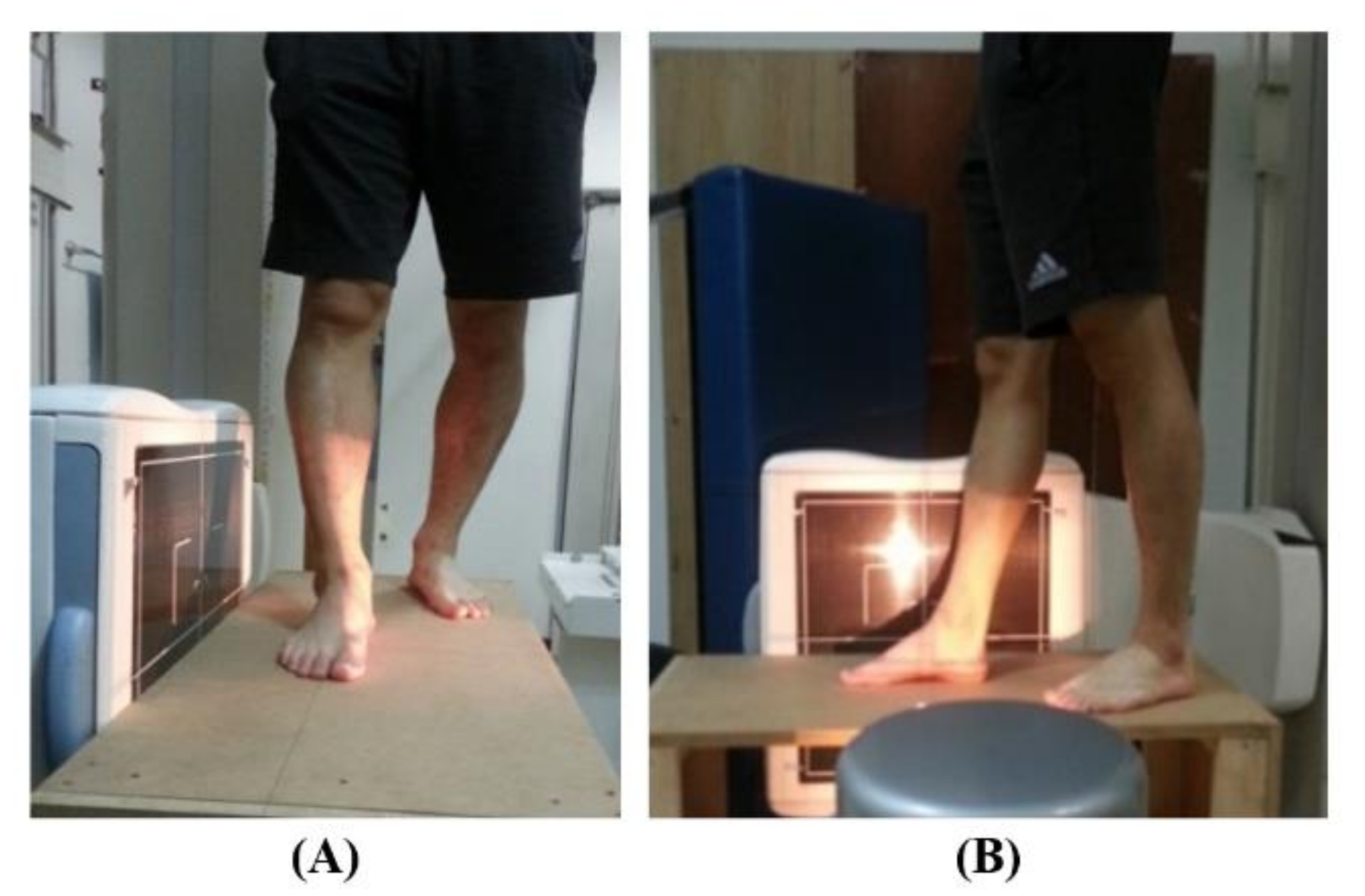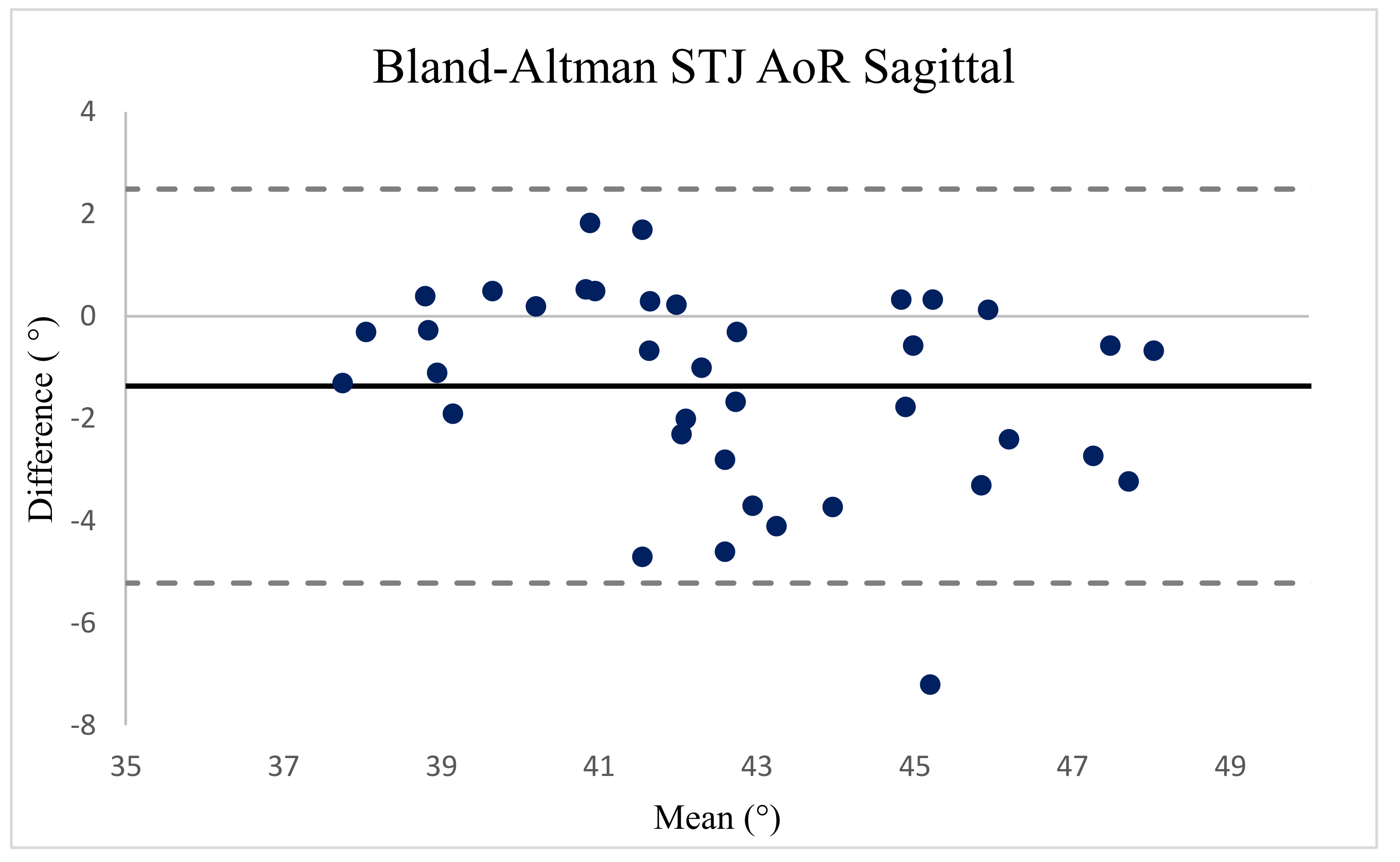Validity and Reliability of a Novel Instrument for the Measurement of Subtalar Joint Axis of Rotation
Abstract
1. Introduction
2. Materials and Methods
2.1. Participants
2.2. Instruments
2.3. Testing Procedures (Validity and Reliability of the STJL for Measuring STJ Inclination)
2.4. Data Analysis
2.5. Statistical Analysis
3. Results
3.1. Test–Retest Reliability
3.2. Construct Validity
4. Discussion
5. Conclusions
Author Contributions
Funding
Institutional Review Board Statement
Informed Consent Statement
Data Availability Statement
Conflicts of Interest
References
- Kirby, K.A.; Opm, M. Methods for Determinlation of Positiona. 1 Var1iations in the Subtalar Joinlt Axis. J. Am. Podiatr. Med. Assoc. 1987. [Google Scholar] [CrossRef] [PubMed]
- Sheehan, F.T.; Seisler, A.R.; Siegel, K.L. In vivo talocrural and subtalar kinematics: A non-invasive 3D dynamic MRI study. Foot Ankle Int. 2007, 28, 323–335. [Google Scholar] [CrossRef]
- Wang, B.; Roach, K.E.; Kapron, A.L.; Fiorentino, N.M.; Saltzman, C.L.; Singer, M.; Anderson, A.E. Accuracy and feasibility of high-speed dual fluoroscopy and model-based tracking to measure in vivo ankle arthrokinematics. Gait Posture 2015, 41, 888–893. [Google Scholar] [CrossRef] [PubMed]
- McClay, I.; Bray, J. The subtalar angle: A proposed measure of rearfoot structure. Foot Ankle Int. 1996, 17, 499–502. [Google Scholar] [CrossRef]
- Lewis, G.S.; Cohen, T.L.; Seisler, A.R.; Kirby, K.A.; Sheehan, F.T.; Piazza, S.J. In vivo tests of an improved method for functional location of the subtalar joint axis. J. Biomech. 2009, 42, 146–151. [Google Scholar] [CrossRef]
- Ying, N.; Kim, W. Use of dual Euler angles to quantify the three-dimensional joint motion and its application to the ankle joint complex. J. Biomech. 2002, 35, 1647–1657. [Google Scholar] [CrossRef]
- Bruening, D.A.; Cooney, K.M.; Buczek, F.L. Analysis of a kinetic multi-segment foot model part II: Kinetics and clinical implications. Gait Posture 2012, 35, 535–540. [Google Scholar] [CrossRef] [PubMed]
- Barg, A.; Bailey, T.; Richter, M.; de Cesar Netto, C.; Lintz, F.; Burssens, A.; Phisitkul, P.; Hanrahan, C.J.; Saltzman, C.L. Weightbearing computed tomography of the foot and ankle: Emerging technology topical review. Foot Ankle Int. 2018, 39, 376–386. [Google Scholar] [CrossRef] [PubMed]
- Krähenbühl, N.; Horn-Lang, T.; Hintermann, B.; Knupp, M. The subtalar joint: A complex mechanism. Efort Open Rev. 2017, 2, 309–316. [Google Scholar] [CrossRef]
- van den Bogert, A.J.; Smith, G.D.; Nigg, B.M. In vivo determination of the anatomical axes of the ankle joint complex: An optimization approach. J. Biomech. 1994, 27, 1477–1488. [Google Scholar] [CrossRef]
- Nester, C. Review of literature on the axis of rotation at the sub talar joint. Foot Ankle Rheum. Arthritis 1998, 8, 111–118. [Google Scholar] [CrossRef]
- Morris, J.; Jones, L. New techniques to establish the subtalar joint’s functional axis. Clin. Podiatr. Med. Surg. 1994, 11, 301–309. [Google Scholar]
- Lundberg, A.; Svensson, O. The axes of rotation of the talocalcaneal and talonavicular joints. Foot 1993, 3, 65–70. [Google Scholar] [CrossRef]
- Phillips, R.; Lidtke, R. Clinical determination of the linear equation for the subtalar joint axis. J. Am. Podiatr. Med Assoc. 1992, 82, 1–20. [Google Scholar] [CrossRef] [PubMed]
- Phillips, R.; Christeck, R.; Phillips, R. Clinical measurement of the axis of the subtalar joint. J. Am. Podiatr. Med Assoc. 1985, 75, 119–131. [Google Scholar] [CrossRef]
- van Langelaan, E.J. A kinematical analysis of the tarsal joints. An X-ray photogrammetric study. Acta Orthop. Scand. Suppl. 1983, 204, 1–269. [Google Scholar] [PubMed]
- Close, J.; Inman, V.; Poor, P.; Todd, F. 15 The Function of the Subtalar Joint. Clin. Orthop. Relat. Res. 1967, 50, 159–180. [Google Scholar] [CrossRef]
- Root, M.; Weed, J.; Sgarlato, T.; Bluth, D. Axis of motion of the subtalar joint. J. Am. Pediatry Assoc. 1966, 56, 149. [Google Scholar]
- Manter, J.T. Movements of the subtalar and transverse tarsal joints. Anat. Rec. 1941, 80, 397–410. [Google Scholar] [CrossRef]
- Pierrynowski, M.R.; Finstad, E.; Kemecsey, M.; Simpson, J. Relationship Between the Subtalar Joint Inclination Angle and the Location of Lower-Extremity Injuries. J. Am. Podiatr. Med Assoc. 2003, 93, 481–484. [Google Scholar] [CrossRef]
- Arndt, A.; Westblad, P.; Winson, I.; Hashimoto, T.; Lundberg, A. Ankle and subtalar kinematics measured with intracortical pins during the stance phase of walking. Foot Ankle Int. 2004, 25, 357–364. [Google Scholar] [CrossRef]
- Nichols, J.A.; Roach, K.E.; Fiorentino, N.M.; Anderson, A.E. Subject-specific axes of rotation based on talar morphology do not improve predictions of tibiotalar and subtalar joint kinematics. Ann. Biomed. Eng. 2017, 45, 2109–2121. [Google Scholar] [CrossRef] [PubMed]
- de Asla, R.J.; Wan, L.; Rubash, H.E.; Li, G. Six DOF in vivo kinematics of the ankle joint complex: Application of a combined dual-orthogonal fluoroscopic and magnetic resonance imaging technique. J. Orthop. Res. 2006, 24, 1019–1027. [Google Scholar] [CrossRef] [PubMed]
- Sheehan, F.T. The instantaneous helical axis of the subtalar and talocrural joints: A non-invasive in vivo dynamic study. J. Foot Ankle Res. 2010, 3, 1–10. [Google Scholar] [CrossRef] [PubMed]
- Montefiori, E.; Modenese, L.; Di Marco, R.; Magni-Manzoni, S.; Malattia, C.; Petrarca, M.; Ronchetti, A.; de Horatio, L.T.; van Dijkhuizen, P.; Wang, A. An image-based kinematic model of the tibiotalar and subtalar joints and its application to gait analysis in children with Juvenile Idiopathic Arthritis. J. Biomech. 2019, 85, 27–36. [Google Scholar] [CrossRef] [PubMed]
- Fassbind, M.J.; Rohr, E.S.; Hu, Y.; Haynor, D.R.; Siegler, S.; Sangeorzan, B.J.; Ledoux, W.R. Evaluating foot kinematics using magnetic resonance imaging: From maximum plantar flexion, inversion, and internal rotation to maximum dorsiflexion, eversion, and external rotation. J. Biomech. Eng. 2011, 133, 104502. [Google Scholar] [CrossRef]
- Goto, A.; Moritomo, H.; Itohara, T.; Watanabe, T.; Sugamoto, K. Three-dimensional in vivo kinematics of the subtalar joint during dorsi-plantarflexion and inversion–eversion. Foot Ankle Int. 2009, 30, 432–438. [Google Scholar]
- Beimers, L.; Tuijthof, G.J.M.; Blankevoort, L.; Jonges, R.; Maas, M.; van Dijk, C.N. In-vivo range of motion of the subtalar joint using computed tomography. J. Biomech. 2008, 41, 1390–1397. [Google Scholar] [CrossRef]
- Bruening, D.A.; Cooney, K.M.; Buczek, F.L. Analysis of a kinetic multi-segment foot model. Part I: Model repeatability and kinematic validity. Gait Posture 2012, 35, 529–534. [Google Scholar] [CrossRef]
- Kidder, S.M.; Abuzzahab, F.S.; Harris, G.F.; Johnson, J.E. A system for the analysis of foot and ankle kinematics during gait. IEEE Trans. Rehabil. Eng. 1996, 4, 25–32. [Google Scholar] [CrossRef]
- Martelli, S.; Valente, G.; Viceconti, M.; Taddei, F. Sensitivity of a subject-specific musculoskeletal model to the uncertainties on the joint axes location. Comput. Methods Biomech. Biomed. Eng. 2015, 18, 1555–1563. [Google Scholar] [CrossRef] [PubMed]
- Campbell, K.J.; Wilson, K.J.; LaPrade, R.F.; Clanton, T.O. Normative rearfoot motion during barefoot and shod walking using biplane fluoroscopy. Knee Surg. Sports Traumatol. Arthrosc. 2016, 24, 1402–1408. [Google Scholar] [CrossRef] [PubMed]
- Koo, S.; Lee, K.M.; Cha, Y.J. Plantar-flexion of the ankle joint complex in terminal stance is initiated by subtalar plantar-flexion: A bi-planar fluoroscopy study. Gait Posture 2015, 42, 424–429. [Google Scholar] [CrossRef]
- Wilhelm, M.P.; Hooper, T.L.; Seeber, G.H.; Browne, K.L.; Sargent, E.; Gilbert, K.K.; James, C.R.; Brismée, J.-M.; Matthijs, O.C.; Matthijs, A. The relationship between measures of foot mobility and subtalar joint stiffness using vibration energy with color Doppler imaging-A clinical proof-of-concept validation study. PLoS ONE 2020, 15, e0237634. [Google Scholar] [CrossRef] [PubMed]
- Kim, T.H.; Moon, S.G.; Jung, H.-G.; Kim, N.R. Subtalar instability: Imaging features of subtalar ligaments on 3D isotropic ankle MRI. BMC Musculoskelet. Disord. 2017, 18, 1–9. [Google Scholar] [CrossRef]
- Roach, K.E.; Foreman, K.B.; Barg, A.; Saltzman, C.L.; Anderson, A.E. Application of high-speed dual fluoroscopy to study in vivo tibiotalar and subtalar kinematics in patients with chronic ankle instability and asymptomatic control subjects during dynamic activities. Foot Ankle Int. 2017, 38, 1236–1248. [Google Scholar] [CrossRef]
- Isman, R.E.; Inman, V.T.; Poor, P. Anthropometric studies of the human foot and ankle. Bull. Prosthet. Res. 1969, 11, 129. [Google Scholar]
- Leardini, A.; Stagni, R.; O’Connor, J.J. Mobility of the subtalar joint in the intact ankle complex. J. Biomech. 2001, 34, 805–809. [Google Scholar] [CrossRef]
- Payne, C.; Munteanu, S.; Miller, K. Position of the subtalar joint axis and resistance of the rearfoot to supination. J. Am. Podiatr. Med. Assoc. 2003, 93, 131–135. [Google Scholar] [CrossRef]
- Parr, W.; Chatterjee, H.; Soligo, C. Calculating the axes of rotation for the subtalar and talocrural joints using 3D bone reconstructions. J. Biomech. 2012, 45, 1103–1107. [Google Scholar] [PubMed]
- Lenz, A.; Strobel, M.A.; Anderson, A.M.; Fial, A.V.; MacWilliams, B.A.; Krzak, J.J.; Kruger, K.M. Assignment of Local Coordinate Systems and Methods to Calculate Tibiotalar and Subtalar Kinematics: A Systematic Review. J. Biomech. 2021, 120, 110344. [Google Scholar] [CrossRef] [PubMed]





| Static Measurement | Day 1 | Day 2 | ICC | SEM | MDD |
|---|---|---|---|---|---|
| Sagittal STJ inclination | 42.22 ± 1.79 | 42.86 ± 1.91 | 0.93 | 0.78 | 2.16 |
| Transverse STJ inclination | 16.15 ± 1.65 | 16.10 ± 1.12 | 0.75 | 0.56 | 1.57 |
| Pearson Correlation (0.798) | ||
|---|---|---|
| Radiographic image | STJL | |
| M ± SD | 42.50 ± 2.76 | 43.58 ± 3.23 |
Publisher’s Note: MDPI stays neutral with regard to jurisdictional claims in published maps and institutional affiliations. |
© 2021 by the authors. Licensee MDPI, Basel, Switzerland. This article is an open access article distributed under the terms and conditions of the Creative Commons Attribution (CC BY) license (https://creativecommons.org/licenses/by/4.0/).
Share and Cite
Kim, B.H.; Lee, S.Y. Validity and Reliability of a Novel Instrument for the Measurement of Subtalar Joint Axis of Rotation. Int. J. Environ. Res. Public Health 2021, 18, 5494. https://doi.org/10.3390/ijerph18105494
Kim BH, Lee SY. Validity and Reliability of a Novel Instrument for the Measurement of Subtalar Joint Axis of Rotation. International Journal of Environmental Research and Public Health. 2021; 18(10):5494. https://doi.org/10.3390/ijerph18105494
Chicago/Turabian StyleKim, Byong Hun, and Sae Yong Lee. 2021. "Validity and Reliability of a Novel Instrument for the Measurement of Subtalar Joint Axis of Rotation" International Journal of Environmental Research and Public Health 18, no. 10: 5494. https://doi.org/10.3390/ijerph18105494
APA StyleKim, B. H., & Lee, S. Y. (2021). Validity and Reliability of a Novel Instrument for the Measurement of Subtalar Joint Axis of Rotation. International Journal of Environmental Research and Public Health, 18(10), 5494. https://doi.org/10.3390/ijerph18105494






